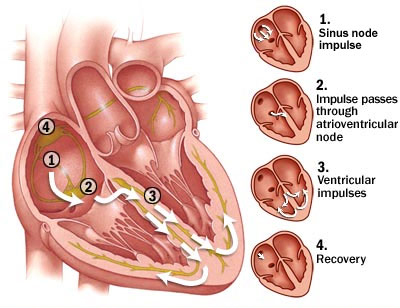Sick Sinus Syndrome
Sick sinus syndrome, also known as bradycardia-tachycardia syndrome or sinus node dysfunction is a collection of heart rhythm disorders that include:
• Sinus bradycardia -- slow heart rates due to a slowing of your heart's own natural pacemaker
• Tachycardias -- fast heart rates
• Bradycardia-tachycardia -- alternating slow and fast heart rhythms
Causes
Overall, sick sinus syndrome is relatively uncommon. Among the various forms of sick sinus syndrome, sinus bradycardia occurs more often than the other types. Tachycardias that arise from the upper chambers of the heart (atrial fibrillation, atrial flutter/tachycardia, and supraventricular tachycardia) are also common forms. A period of elevated heart rates is typically followed by very slow heart rates when the tachycardia ends. Abnormal heart rhythms are often worsened by medications such as digitalis, calcium channel blockers, beta-blockers, and anti-arrhythmics. Disorders that cause scarring, degeneration, or damage to the conduction system of the heart can cause sick sinus syndrome. Sick sinus syndrome usually occurs in people older than 50, in whom the cause is often a non-specific, scar-like degeneration of the heart's conduction system. In children, a common cause of sick sinus syndrome is heart surgery, especially on the upper chambers. Coronary artery disease, high blood pressure, and aortic and mitral valve diseases may be associated with sick sinus syndrome, although those diseases may have nothing to do with the syndrome.
Symptoms of Sick Sinus Syndrome
Fainting or near-fainting, Dizziness or light-headedness, Confusion or other changes in mental status, Sensation of feeling the heart beat (palpitations), Chest pain or angina, Shortness of breath Fatigue

Exams and Tests
The symptoms are non-specific and may mimic other disorders. The patient's heart rate may be very slow at any time. Blood pressure may be normal or low.
Sick sinus syndrome may cause symptoms of heart failure to occur or worsen. Sick sinus syndrome is diagnosed when the symptoms occur only during episodes of arrhythmia. However, this often is difficult to prove.An ECG may show various arrhythmias characteristic of sick sinus syndrome. Exercise testing has not proven particularly effective as a screening tool. Holter monitoring is an effective tool for diagnosing sick sinus syndrome because of the episodic nature of the disorder. Extremely slow heart rate and prolonged pauses may be seen during Holter monitoring, along with episodes of atrial tachycardias. An EPS (intracardiac electrophysiology study) is a very specific test for this disorder, although it is often unable to confirm the diagnosis.
Treatment
If the disorder is not causing symptoms, treatment may not be necessary. Your doctor may evaluate any medications you are taking to make sure they are not worsening your condition. Do not stop taking any medication unless instructed by your doctor. A permanent implanted pacemaker may be necessary when it has been established that the symptoms are related to bradycardia (slow heart rate). Any associated tachycardia (a fast heart rate) may be treated with medications. The person will be protected from symptomatic bradycardia by a permanent implanted pacemaker. Sometimes a catheter procedure called radiofrequency ablation is used to eliminate tachycardias.
Outlook
This syndrome is slowly progressive. As long as the person remains without symptoms, no treatment is necessary. If a permanent pacemaker is implanted, the long-term outlook is excellent.
Possible Complications
• Inadequate heart pumping
• Heart failure
• Falls or injury caused by fainting
• Angina
Acknowledgements
Heart Rhythm Specialists of South Florida gives special thanks to the National Library of Medicine and National Heart Lung and Blood Institute whose Web sites aided in the research of the patient educational material provided above.






